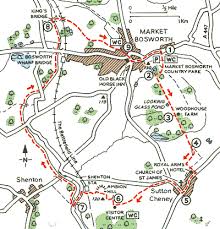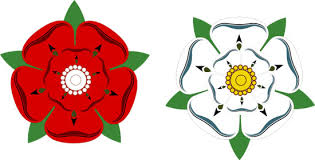

 The Battle of Bosworth Field, the most famous battle of the War of the Roses, was fought on August 22, 1485 and marked the end of the civil war
between the houses of York and Lancaster, two rival branches of the royal family fighting for control of the throne.
Richard III (of the house of York) was killed and Henry Tudor ( of the house of Lancaster) was crowned king Henry VII and founded the Tudor dynasty that was to include Henry VIII and
Elizabeth I.
A contemporary name for the civil war was
'The Cousins' War'. The term War
of the Roses was not used until much later.
The Battle of Bosworth Field, the most famous battle of the War of the Roses, was fought on August 22, 1485 and marked the end of the civil war
between the houses of York and Lancaster, two rival branches of the royal family fighting for control of the throne.
Richard III (of the house of York) was killed and Henry Tudor ( of the house of Lancaster) was crowned king Henry VII and founded the Tudor dynasty that was to include Henry VIII and
Elizabeth I.
A contemporary name for the civil war was
'The Cousins' War'. The term War
of the Roses was not used until much later.
In 1483 Richard of Gloucester had maneuvered to have his twelve year old nephew, who had been crowned Edward V following the death of his father, declared illegitimate and therefore unable to inherit the throne. Richard then seized the thrown and was crowned Richard III. His two nephews, Edward V and Richard of Shrewsbury, were taken to the Tower of London and were never seen in public again. Today they are often romantically referred to as The Princes in the Tower.
During an earlier battle of the civil war in 1471, the Lancastrian King Henry VI and his only son, Edward of Lancaster,
died in the Battle of Tewkesbury. Their deaths had left
the House of Lancaster with no direct claimants to the throne.
Henry Tudor's mother, Lady Margaret Beaufort, was distantly related to kings Richard II and Henry IV. This trace of the royal bloodline, as weak as it was, allowed the ambitious Henry Tudor to make a claim for the throne.
To further strengthen his claim, Henry Tudor swore an oath to marry Edward IV's daughter, Elizabeth of York (the sister of the two Princes in the Tower), thereby uniting the houses of York and Lancaster.
Henry
had a force of about 5000 men, very few of them being Englishmen. French mercenaries made up the core of Henry's army.
Richard’s army was close to
12,000. However, 4,000 of these soldiers belonged to the Stanley family
and no one was sure which side the Stanley’s would ultimately fight for. The reason: Lord Stanley was part of Richard's court BUT his second wife was Margaret of Beaufort, Henry Tudor's mother. A conundrum.
When the fighting began early in the morning of August 22, 1483,
The Stanley armies hung back from the actual fighting until very late in the battle when they threw their armies into the fray on the side of Henry Tudor and effectively insured his victory.
Casualties on both sides of the battle were heavy. In two and a half hours between 1,000 and 1,500 men died and countless more were injured.
After Richard III's death his body was stripped and strapped across a horse to be taken to Leicester and exhibited publicly for two days so there would be no doubt in the minds of the people that he was dead.
Richard was then buried by the Greyfriars in the private area of their church. The church was later demolished when Henry VIII broke from Rome, created the Church of England with himself as head, and dissolved all monasteries and nunneries.
For centuries the exact location of Richard's tomb was unknown until, on September 12, 2012 a battle damaged skeleton was discovered within the remains of an old church in Leicester. DNA testing conclusively identified them as the remains as those of King Richard III.
Sometime after the Battle of Bosworth Henry VII married Elizabeth of York uniting the houses of Lancaster and York and ending the feud between the two.

 Today, Bosworth Field is serene with very little trace of the battle that took place here.
Today, Bosworth Field is serene with very little trace of the battle that took place here.
Postcript: Someone asked for an update on the bacon I made awhile ago: we ate it all and it is time to make it again. Yum.
 Today, Bosworth Field is serene with very little trace of the battle that took place here.
Today, Bosworth Field is serene with very little trace of the battle that took place here.
No comments:
Post a Comment